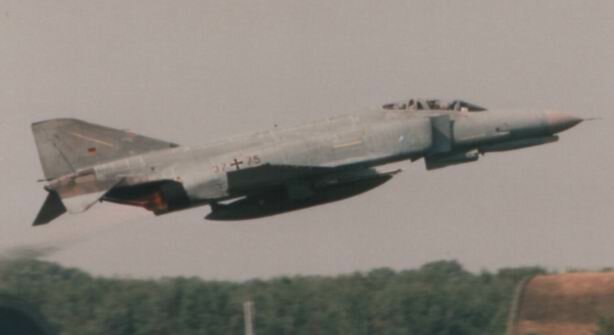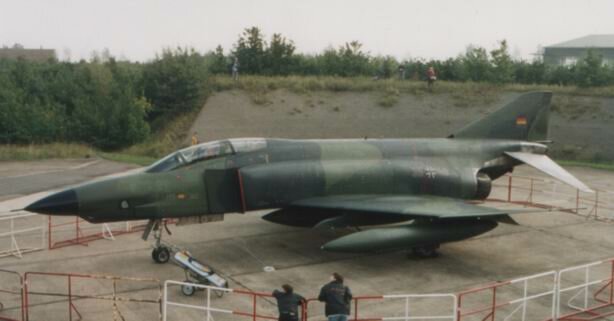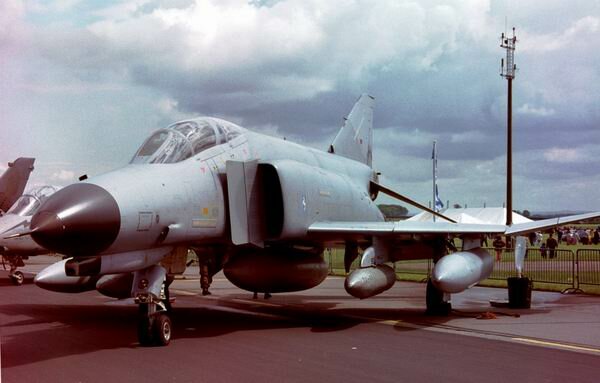|
From ACIG.org ACIG Database
The starting point for the German F-4 purchase was a change in NATO doctrine made in 1967. The switch from totally nuclear passed defense to a more flexible response highlighted the need for a new and better fighter. The F-104G (the standard fighter of the Luftwaffe at that time) was not capable to fulfill the increased demands. The following requirements were set in the tender for the new fighter : · Fast availability. The aircraft had to ready for service in 1974 · The base of the new aircraft had to be a proven design. Technical and financial risks should be minimal. · Full NATO compatibility · Second generation aircraft. Maneuverability better then MiG-21 in middle and lower flying heights · All weather navigation capability · 2 engines (The high looses for the Starfighter made the Luftwaffe prefer a 2 engined fighter) · should be able to use available logisitcs The following contenders were evaluated : · British Aerospace Jaguar · Saab Viggen · Dassault Mirage F1 · Northrop F-5 · Northrop P 530 (successor to the F-18) · McDonnell Douglas F-4 The F-4 was seen as the plane which fulfilled most of the demands set by the Luftwaffe. The first concepts saw the F-4F as a single seater F-4 variant. The rear cockpit was to be faired over. But because of increased costs for those changes the idea was dropped. ( An additional factor was the good experience the Luftwaffe had with the RF-4E already in service) So on the 24th June 1971 the Bundestag (German parliament) decided to purchase 175 F-4F Phantom II for a unit price of 12 Mio DM. German industry was heavily involved in building the F-4F. Many components were manufactured in Germany. The rear, the outer wing, rudders and other components were build by MBB in Germany. (MBB produced over 500 such kits, so that around 10% of all F-4 flying were made using components made in Germany), and only the first F-4F was build without using the German kits. Furthermore the engines of the German F-4Fs were built in Germany. MTU built the 448 units of the J79-GE/MTU-17A engine, after having built around 1250 J79-GE-11A for the F-104G. About 60% of the parts were delivered by General Electric the other 40% and the final construction were made by MTU in Germany. The kit to change the -17A into smokeless -17B or -E variants of the engine was never purchased by Germany. The first German F-4F flew on the 18th March 1973, while the official roll-out was later on the 24th May 1973. The first 12 F-4F were sent directly to the 35 TFW at George AFB California to be used for pilot training. On 1st January 1974 the first crews from Jagdgeschwader 71 (Fighter Wing 71) “Richthofen” commenced training on the F-4F there. Those F-4F were replaced by 10 specially purchased F-4E. Those F-4E were retired in 1997 and today the F-4F is back serving in the training role with the 20th FS at Holloman AFB New Mexico. (Those F-4F are painted in US camouflage markings and wear US Air Force insignia) The first F-4F to touch down on German soil was 37+04, which was not to be flown again as it went directly to to the technical ground school and has remained there ever since. The following units of the Luftwaffe changed to the F-4F : - JG 71 Richthofen changed from F-104 G to F-4F in 1974 - JG 74 Mölders changed from F-104 G to F-4F in 1974/75 - JBG 36 Westfalen (Fighter Bomber Wing 36) changed from F-104 G to F-4F 1974/1975 - JBG 35 changed from Fiat G-91 toF-4F in 1975/1976 The last F-4F called “Spirit of Cooperation” was delivered to the Luftwaffe on the 1st October 1976. The Luftwaffe F-4F are Block 52 to Block 59 aircraft, which were considerably different to the F-4E: - The seventh fuel cell was not installed - Non slotted stabilators - Simplified APQ-120 V5 radar set - No provision for AIM-7 Sparrow missiles - Introduction of leading edge slats to improve maneuverability (later added to F-4E). The APQ-120 V5 radar set is unable to support the AIM-7 sparrow missile, nor was the wiring for the AIM-7 installed. The range of the APQ-120 V5 was around 100 km, but it offered no useful look-down/shoot-down capability. The ability to engage multiple targets was also not incorporated. The radar offered useable navigation and ground attack modes. Air to ground weapons were limited to dumb bombs and rockets. The RWR was the AN/ALR-46 type. This system is able to detect pulsed signals only. A display and sound signals alerted the crew to the danger. The AN/ALQ 101 ECM pod was regularly carried in front left sparrow bay. The F-4F was very limited as a fighter as the only weapons were the AIM-9B Sidewinder (max. 4 could be carried) and the M-61A1 gun. So the plane was only capable of rear attacks from close range. This meant that the aircraft had to be put at great risks in an engagement. Experiencing the true capabilities of the F-4F in service, the Luftwaffe concluded that those would not be sufficient for the future. So already in 1975 a plan for an update of the fleet was devised, intending to improve the conventional weapons capability. This was seen as necessary to give the F-4F new weapons to counter the threat of the Warsaw Pact forces. Furthermore it was decided to make the F-4F capable to use most of the weapons the American F-4s – of which almost 500 were stationed in the Europe at the time – could use. In 1976 Germany and the USA signed a “Memorandum of Agreement” to achieve those goals: the “Peace Rhine” program was initiated in 1980 and ended in 1984. The core of the update was the installation of digital and programmable weapons computer LRU 1. To make it compatible with the analogue flight data sensors the Signal Conditoner Converter Unit (SCCU) was added. Further improvements were : - Radar beacon for the APQ-120 radar rto drop bombs through clouds - Installation of a Digital Scan Converter Group for radar and optical pictures on the scope - Addition of Computerized Automatic Acquisition to improve air to air combat - Replacement of Aero 3B launch rails by LAU-7A/5 (FRG) rails to accept AIM-9L missiles - Change of weapons delivery panel to employ AIM-65 B Maverick - Modification to the cockpit with “Maverick” hand control unit - Improvement of the inner wing pylon to accommodate LAU-118 (one-round) launch rails for AGM-65 Maverick missiles - Introduction of AIM-9L all aspect IR missile - Exchange of AN/ALR 46 RWR gear with AN/ALR 68 , especially developed by Litton for the Luftwaffe - Retro fitment of inner wing pylons with two AN/ALE 40 chaff and flare dispensers - Replacement of Royal Jet 600 gal. centerline tank by the HPC taken from the F-15 - AN/ALQ 101 ECM pod supplemented with AN/ALQ 119 ECM pods (many AN/ALQ 101 were retrofitted to AN/ALQ 119 standard) After this update the F-4F was well equipped for the air to ground role, but still lacked improved air-to-air capabilities. The “Peace Rhine” program did not include provisions for the AIM-7 Sparrow, so the F-4F was still limited to visual air combat. With the new generation of MiG-fighter planes being fielded by the Warsaw Pact air forces, it became obvious that something had to be done. The F.Mk.3 fighter version of the MRCA Tornado was not suited to German needs. So the UK, Italy, Spain and Germany decided to develop a new fighter. (originally called “Jäger 90” – “Fighter 90” – in German, but eventually being developed into what is today the Eurofighter EF-2000 Typhoon). The basic idea was for this aircraft to enter service in the late 1990s. To fill the gap until this new fighter would be in service it was decided to give the F-4F yet another improvement program: as it was obvious that the F-4F would have to remain in service after the year 2000, it was decided that a SLEP (service life extension program) and an avionics update was needed. In 1983 the first demands for such an upgrade were defined. The demands for the air defense role were : - All weather capability - Long range engagement capability - Look-Down/Shoot-Down capability - Multiple targets engagement capability - Track-While-Scan capability - Use of radar guided AAM even under enemy jamming The demands for the ground attack role were not that far reaching : - Improved navigation - Use of guided munitions - Use of stand-off weapons - All weather capability The ensuing “Kampfwertsteigerung” (KWS) – better known as “ICE” (improved combat efficiency) – program consisted of three steps. The first step was the SLEP. All 156 remaining F-4Fs were to go through this program, which included: - Overhauling the airframes so to increase the structural-life for 6000 additional flight hours, while giving potential for up to 10.000 additional flying hours - Extension of planed depot maintenance (PDM) intervals from 54 to 72 months, reducing lifecycle costs - Preventive inspection and repairs at an early stage - Dividing the fuselage into structural problem zones - Reworking areas with proven structural fatigue The basic avionics update was also given to the whole fleet and contained the following : - Integration of a Honeywell Laser INS - A GEC Macroni digital air data computer CPU-143/A - A Rockwell-Collins unit for the LINS - Installation of a MIL Std 1553 digital data bus Only 43 F-4Fs went through stages 1 and 2. Those were designated as LA (Luftangriff = Ground Attack) variants and can be easily distinguished from the full ICE variant by the black radomes, under which the old APQ-120 radar was retained. Stage 2 of the ICE update was given to the remaining 113 F4-Fs. The core of this update is the AN/APG-65Y radar and the AIM-120 AMRAAM missile. It contains : - Hughes AN/APG-65 radar set, produced under license by DASA in Germany - A Litef mission computer to increase the weapons computer’s capacity. - New radar hand control panel for the rear cockpit - AIM-120 launch rails installed in AIM-7 Sparrow bays, provided by Airscrew Howden - A new gray random by Marion Composites. Optimized for the APG-65 emissions. The integration of the AN/APG-65 and the AIM-120 AMRAAM were made in Point Mogu during 1991/1992. Interestingly 3 former US Navy F-4N were bought by the Luftwaffe and used as QF-4Ns during the trails. Luckily all 3 QF-4N survived the tests and were sold back to the US Navy. With the full air defense upgrade installed the F-4F is still is a potent and dangerous opponent. Yet, even this upgrade had still several weaknesses. Surprisingly, the F-4F was never equipped with an enemy IFF-interrogator. That means the crew has no means to properly identify potential opponents operating outside the visual range. This is seriously reducing the effectiveness when the aircraft are operating without AWACS or tight countrol from the ground based radars. With the F-4Fs service life nearing its end and the Eurofighter Typhoon just about entering service, the Luftwaffe's F-4Fs will see only few updates in the next few years. Planned are: - Update of the AN/ALR-68(V1) RWR to AN/ALR-68(V3) or DASI standard. This is a pure software update and will give the capability to detect continuos wave signals - A new IFF-transponder will be introduced - The gun camera will be replaced by a video based system - Old UHF radios will be replaced with UHF and VHF radios The first F-4F were equipped with that changes in 1999. But it seems unlikely that the whole fleet will receive those updates.
Jagdgeschwader 71 “Richthofen” (Fighter Wing 71) Jagdgeschwader 71 was formed on the 30th August of 1958. It was equipped with Canadair Sabre Mk. 6. On 21st April of 1961 the Name “Richthofen” was given to the wing. The symbol of the wing (a red “R” ) is painted on the intakes of the F-4Fs. In May 1963 the wing converted to the F-104G. On 7th March 1974 the first F-4F touched down at Wittmund AB and the wing started to transition to the F-4F. On the 1st July 1975 the transition was completed and the wing was declared combat ready later that year. Today JG 71 is equipped with around 30 F-4F ICE. Current plan is for the wing to continue flying F-4F until 2012, which would make it the probably last Phantom-wing within the Luftwaffe. Jagdgeschwader 72 “Westafeln”/Flight Training Center Formed as JBG 36 (JBG = Jagdbomber Geschwader = Fighter Bomber Wing) in March 1961 the wing was equipped with the F-84F Thunderstreak. In 1965 the wing transitioned to the F-104G Starfighter. The first F-4Fs arrived in 1974 and the wing was declared combat ready on the F-4F in 1976, with the main task of ground attack. With the end of the WarPac the importance of the F-4F vanished and the Wing became a pure Fighter Wing in 1991. From then on it was called JG 72 “Westfalen”. JG 72 was disbanded in 2002 as a result of cutbacks in the German Defense budget. One squadron of 16 F-4F remained, acting as a training unit for pilots fresh from training in the US. This new unit is called “Fluglehrzentrum”. It took over the badge of the JG 72 and has sent the display aircraft to the airshow seasons in 2002 and 2003. The unit will be disbanded in 2006 and the base at Rhein-Hopsten will close then. Jagdgeschwader 73 “Steinhoff” JG 73 was formed in 1959 at Alhorn AB, Germany. It was first equipped with the Canadair Sabre Mk. 6. In 1960 it was relocated to the Pferdsfeld AB in the “Pfalz”. After getting the Fiat G.91 in 1964 JG 73 was renamed JBG 42 and again renamed to LeKG (Leichtes Kampfgeschwader = light Fighter Wing) in 1967. In 1975 the F-4F arrived and with it another name change, this time to JBG 35. JBG 35 did not give up the secondary ground attack role even after reunification and made an historic flight in April 1994, when F-4F from this wing were the first fighter aircraft to overfly the Branderburger Tor in Berlin since reunification. In 1995 it was decided that the Luftwaffe should have one fighter wing in the area of the former Eastern Germany. So JBG 35 and the Test Wing MiG-29 became the JG 73. The new base was Laage in eastern Germany. The F-4F deployed to Laage AB in 1997. JG 73 will be the first wing to switch to the Typhoon, the first aircraft are still expected to arrive in 2003. Jagdgeschwader 74 “Mölders” JG 74 was officially formed on 5 May 1960. It was equipped with F-86K Sabre all-weather fighters. In July 1964 the transition to the F-104 G started. In 1973 the name “Mölders” was given to the wing. From July 1074 to February 1976 the wing transitioned to the F-4F. The wing is currently equipped with 30 F-4F ICE. The wing is expected to receive the Eurofighter Typhoon on 2005/6. Wehrtechnische Dienststelle 61 WTD 61 The German Test Wing based at Manching in southern Germany is flying a small number of F-4Fs for use in various testing programs. For example it played a part in the development of the Greek F-4F “Peace Ikarus” upgrade program. 20th FS USAF Holloman AFB This official USAF squadron is flying German F-4F Phantoms to train german aircrew on the type. The Silver Lobos are the last USAF squadron flying the F-4 in active service. Those planes are unique as they are flying in full USAF markings and wear the standard USAF camouflage scheme.
© Copyright 2002-3 by ACIG.org |





